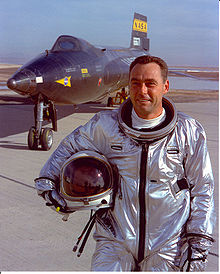William John Knight
William John "Pete" Knight (born November 18, 1929 in Noblesville , Indiana , † May 7, 2004 in Duarte , California ) was an American test pilot and politician . With 7274 km / h, set up with a North American X-15 , it holds the world record for a manned aircraft.
Life
Air Force pilot
Knight joined the US Air Force in 1951 . There he was trained as a pilot until 1953. After graduating from the Air Force Institute of Technology in 1958 with a Bachelor of Science degree in Aeronautical Engineering, he went to the test pilot school at Edwards Air Force Base , which he graduated that same year. He then worked at Edwards AFB as a test pilot for the types F-100 , F-101 , F-104 , T-38 and F-5 .
In April 1960 he was one of seven pilots selected for the planned Air Force space glider Dyna-Soar . The project was discontinued in 1963 without a flight. However, Knight graduated from the new Aerospace Research Pilot School.
In 1964, Knight switched to the X-15 project , in which the Air Force and NASA jointly tested a rocket aircraft . He performed his first flight on September 30, 1965.
On June 29, 1967, the entire electrical system of the X-15 failed during the climb. Knight climbed to 173,000 ft (approx. 52,700 m) and landed on sight while gliding, for which he was later awarded the Distinguished Flying Cross . On another flight, Knight reached the record speed of 7273 km / h (Mach 6.7) on October 3, 1967. Since the flight has not been registered by the FAI , the international air sports association , the speed record is not official. On October 17, 1967, Knight ascended the X-15 to an altitude of 85,500 m. According to the definition of the US Air Force, it crossed the border into space and was awarded with astronaut wings . Knight made a total of 16 flights with the X-15, the last on September 13, 1968.
After the X-15 project was completed, Knight flew 253 combat missions in the Vietnam War , after which he became test director for the F-15 at Wright-Patterson Air Force Base . He later became head of the Fighter Attack System Program Office there. In 1979 he was appointed head of the Air Force Flight Test Center at Edwards AFB, where he still flew the F-16 as an active test pilot . Knight retired from the Air Force in 1982 with the rank of Colonel .
Political career
As a Republican member , Knight was elected to the city council of Palmdale in 1984 and became mayor in 1988 . In 1992 he was elected to the California State Assembly and in 1996 to the California Senate .
Knight was the author of Proposition 22 , an amendment to the California Family Act that same-sex marriage was invalid and unrecognized in California. In the referendum on March 7, 2000, 61.4% voted for the change in the law. The discussion had also gotten explosive from Knight's homosexual son David, who said that after he came out, his father had broken off contact with him.
Private
Knight was married with three biological sons and four step-sons. He died of leukemia on May 7, 2004 .
Honors
Knight received the following military awards, among others:
- Legion of Merit
- Distinguished Flying Cross
- Air Medal
- Induction into the National Aviation Hall of Fame
- Admission to the Aerospace Walk of Honor
- Induction into the International Space Hall of Fame
Knight High School in Palmdale is named after him.
In 2012 the asteroid (8030) Williamknight was named after him.
Web links
- NASA: William J. Knight (English)
- spacefacts: Spacefacts.de short biography
Individual evidence
- ^ Gunter Krebs: X-15 History. In: Gunter's Space Page. April 8, 2014, accessed July 11, 2014 .
- ^ William J. Knight. NASA, October 1999, accessed July 11, 2014 .
- ^ David G. Lawrence: California: The Politics of Diversity . Cengage Learning, 2012, p. 66 ( limited preview in Google Book search).
- ^ State Ballot Measures. California Secretary of State, June 2, 2000, archived from the original July 22, 2012 ; accessed on July 11, 2014 .
- ^ David Knight: My Father Is Wrong on Gays. Los Angeles Times, October 14, 1999, accessed July 11, 2014 .
- ↑ Richard Fausset: GOP's Pete Knight, 74; Former Test Pilot Was Foe of Gay Marriage. Los Angeles Times, May 9, 2004, accessed July 11, 2014 .
- ↑ X-15 astronaut Pete Knight dead at 74. collectspace.com, May 8, 2004, accessed on July 11, 2014 .
- ↑ International Space Hall of Fame. New Mexico Museum of Space History, accessed July 11, 2014 .
- ↑ Minor Planet Circ. 78269 (PDF)
| personal data | |
|---|---|
| SURNAME | Knight, William John |
| ALTERNATIVE NAMES | Knight, Pete |
| BRIEF DESCRIPTION | American astronaut, test pilot and politician |
| DATE OF BIRTH | November 18, 1929 |
| PLACE OF BIRTH | Noblesville , Indiana |
| DATE OF DEATH | May 7, 2004 |
| Place of death | Duarte , California |
